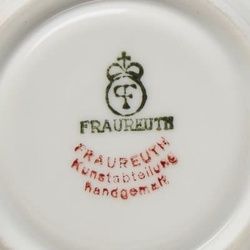
До начала 19 века во Фраройте жили только фермеры и ремесленники. В ходе индустриализации Германии Фраройт также стал промышленным центром. В непосредственной близости ткацкое и прядильно-прядильное ремесла поначалу переживали наибольший подъем. Задокументирована мастерская по расчесыванию шерсти, основанная Грейзером Георгом Беком в 1802 году в центре Фраройта.
В 1818 году мастера объединились в смешанную гильдию. К ней принадлежало 28 мастеров, в 1843 году их было уже 78. В середине 19 века производственный профиль фирмы Бека был изменен. Внук Георга Бека, Георг Бруно Федиш, должен был войти в бизнес деда. Однако ему, похоже, не нравилась эта работа, потому что в конце концов он уехал в Глаухау и проработал там на ткацкой фабрике восемь лет. От родственника он узнал кое-что о заманчивых возможностях производства фарфора и отправился в богемский Клёстерле.
Там он познакомился с секретами производства фарфора чешскими фарфоровыми мастерами. Вернувшись во Фраройт в 1865 году, он начал преобразовывать старую мастерскую по расчесыванию шерсти в современную фарфоровую фабрику.Вместе со своим двоюродным братом Арведом фон Рёмером, владельцем поместья из соседнего Унтерплайса (сегодня Штайнплейс), он основал «фарфоровую фабрику Ремера и Fedisch Fraureuth» в 1865 году.
Чешские производители фарфора обучали местных рабочих. Затем производство удалось начать в 1867 году с 60 рабочими и двумя круглыми печами. Фабрика постоянно расширялась. В итоге он занял площадь 73328 м2. Позже в 29 корпусах действовало 12 больших печей, а в 1885 г. работало 600 рабочих. Незадолго до Первой мировой войны их было 1500. Для производства использовались минералы полевой шпат и каолин из Богемии и Баварии, а также уголь из горнодобывающего района Цвикау. Продажи разработанной продукции по всему миру. Образцовые магазины в Берлине, Вене, Гамбурге и Лондоне, а также представители здесь, а также в Париже и Милане поддерживают продажи. Жители Фраройта сначала получили своих арканистов из Баварии и Богемии.
После смерти Бруно Федиша в 1885 году вдова Федиш и Ремер преобразовали фабрику в акционерное общество в 1891 году. Работа на заводе — сдельная — была тяжелой. Постоянное чередование зноя и холода, сквозняков, воды, пыли, совладание с обширным транспортом - подъем и спуск почти без технических средств - напрягали людей. Многие производители фарфора страдали истощением, чахоткой и туберкулезом, многие умерли молодыми.
На фабрике было много объектов социального обеспечения, таких как школа рисования, столовая, сберегательная касса, больница, водоснабжение и пожарная часть. Здесь тоже были острые споры между хорошо организованными рабочими и обществом. В 1911 году, например, была 26-недельная забастовка за улучшение условий труда и жизни. В 1912/13 г. AG столкнулся с небольшими потрясениями, которые были компенсированы технической реорганизацией. В 1913 году бизнесмен Феликс Зингер приобрел пакет акций у основного акционера Kommerstädt. Он не получил признания от Fraureuters.
Первая мировая война не принесла финансовых потерь заводу. К 1916 году продажи превзошли самые высокие показатели мирного времени. На Лейпцигской осенней ярмарке 1916 года компания представила новинки формы, цвета и декора, которые критики оценили как «превосходно красивые». Во время войны компания Fraureuth изображала императоров, королей, цеппелины и подводные лодки на вазах и тарелках, но в остальном оставалась верна своему принципу: то, что они делали, было практично, просто и красиво. Принцип компании был: Фарфор должен доставлять удовольствие!
В середине 1919 года Фраройт приобрел мануфактуру Валлендорфер в Тюрингенском лесу, известную своими кофейными и чайными сервизами по мейсенской модели и фигуративным скульптурам. Живопись в Лихте была прикреплена к Валлендорфу. Это означало разделение труда: с тех пор во Фраройте в основном производился широкий ассортимент повседневной и элитной посуды всех ценовых категорий. Основой компании был экспорт, в основном в США. Предпочтительными клиентами были также национальные и международные судоходные линии.
Инфляция имела разрушительные последствия для компании. В это время тотальной девальвации валюты продукты Fraureuth были слишком дорогими для внутреннего рынка из-за их очень хорошего качества. Важнейший отечественный бизнес оборвался, потому что можно было продавать только дешевые массовые товары низкого качества. Деньги можно было заработать только за границей. После 1922 г. на жилищное строительство ушло еще 25 млн марок и 50 млн марок на новую посудную фабрику (открытую в феврале 1923 г.), через год дела пошли под откос. Компания по уши в долгах. Кредиторы удерживают деньги, более крупные заказы приходится отклонять. В 1925 году Fraureuth закрыл туннельные печи. 30 сентября 1925 года генеральный директор Зингер покинул совет директоров. 31 января 1926 года было объявлено о банкротстве.
Аукцион искусства и старины art-picture.ru предоставляет возможность покупки
приобрести представленны лоты по теме "Fraureuth /Фрауройт/"









